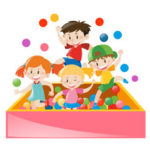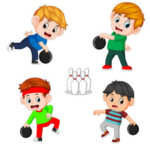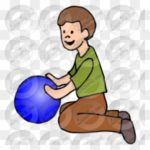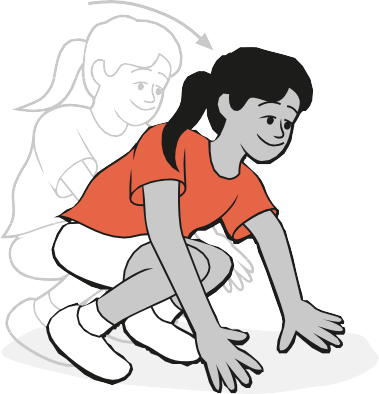
by Santosh | Jun 11, 2020 | Fitness Activity
Movement skills/concepts
Falling to land on front support and awareness of the body in personal and general space.
Set-up
Variety of landing surfaces, crash pad, mats. Children are freely spaced.
Activity
Children practice the following activities:
- from kneeling, put your fingertips on the ground, then, by pressing down, ‘squeeze’ the water out of an imaginary sponge
- from crouching, fall forwards and stop before your stomach touches the ground
- try the above on varied landing surfaces, over elastic or flexi cord
- from standing, fall forwards like a tree being felled, dominoes (group), a wave at the beach,
- play ‘Timber Tag’ in a defined area with several taggers – when a player is tagged, they fall forwards calling ‘Timber’ and become the new
Can you see …?
- bending of fingers, palms, heels of hand, then elbows
- fingers slightly inwards, hands flat
- straight back, tightened tummy
You could ask …
How do you feel about falling forwards?
What do you need to do to land safely on your hands/arms?
COOL DOWN/ CLOSURE
Review Skill/Activity, stretching, and questions.
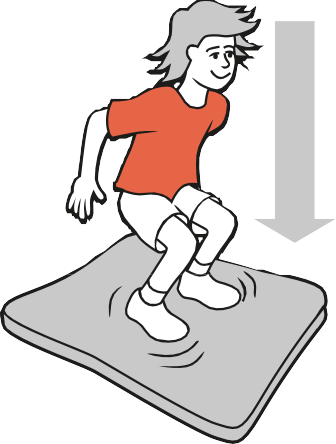
by Santosh | Jun 11, 2020 | Fitness Activity
Movement skills/concepts
Jumping, landing and balancing, space awareness (levels and directions) and relationships (with equipment).
Set-up
Ropes and bases/discs.
Children are spread out, with one rope and one base/disc each, in a level grass or hard area.
Activity
Can you …?
- stand on your base and, on the signal, try to jump (high to give you more time in the air) and click your heels together before you land – how many clicks can you do before landing and can you land on your base?
- jump from your base and see how many times you can clap your hands together before you land – as your feet touch the ground, freeze your body, perfectly still and stay in that position for three seconds
- jump over a rope and land on the other side without falling down – think of your feet sinking into the floor as if the floor were a sponge and freeze in that position for three seconds
- jump over your rope in different ways – try to take off on one foot and land on two
- change the direction of your jump to land – jump forwards, backwards, sideways
- jump high in the air as you travel over your rope and land as softly as you can – freeze and hold for three seconds
- jog, run, skip, gallop, hop, etc and, on the signal, jump to land – freeze and hold for three seconds
Can you see …?
- toe–ball–heel landing sequence
- knees bending after heels contact the ground
- straight back
- holding or ‘stick’ balance
- head up, looking straight ahead
You could ask …
Which ways of jumping did you enjoy the best?
What position did you hold when you landed on your feet?
Why do you need to hold this position for at least three seconds?
Variations
Vary object: Jump over different objects (e.g. beanbags, balls, low-level box tops, benches).
COOL DOWN/ CLOSURE
Review Skill/Activity, stretching, and questions.

by Santosh | Jun 11, 2020 | Fitness Activity
Movement skills/concepts
Balancing using equipment, body and space awareness.
Set-up
Hanging ropes with mats underneath.
Activity
On a hanging rope, children explore ways of balancing in an upright position.
Can you hang while …?
- supporting your weight with your hands
- supporting your weight with your hands and legs
- creating some basic shapes (e.g. wide, narrow, curled and twisted with your free body parts)
- creating symmetrical and asymmetrical shapes
Can you see …
- tight muscles
- tight grip on the rope
You could ask …
What do you need to do with your body to hold your position on the rope?
Variations
Inverted balance: If children have sufficient upper arm/shoulder strength, try an inverted balance on the hanging rope.
COOL DOWN/ CLOSURE
Review Skill/Activity, stretching, and questions.
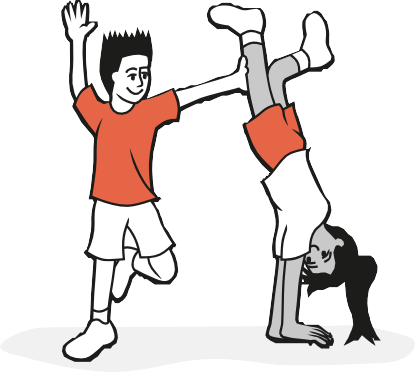
by Santosh | Jun 10, 2020 | Fitness Activity
Movement skills/concepts
Cooperative balances, counterbalance, space and body awareness, and relationships (with others).
Set-up
Mats scattered in a defined area with an even surface.
Children in pairs, matched for height and weight, and with one mat per pair.
Activity
With your partner, children create a balance that has one wide and one narrow shape. Partners need to work together to partially support each other’s weight.
Children create different balances with their partner where they are partially supporting each other’s weight, then totally supporting each other’s weight.
Create a balance where one partner performs an inverted balance.
Can you see …?
- wide base of support
- extending body parts to counterbalance
- tight muscles
You could ask …
How can you safely support each other’s weight?
COOL DOWN/ CLOSURE
Review Skill/Activity, stretching, and questions.
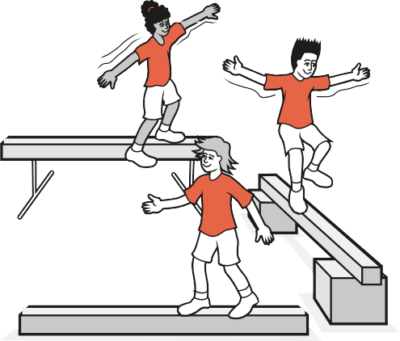
by Santosh | Jun 10, 2020 | Fitness Activity
Movement skills/concepts
Dynamic and static balance, space awareness and relationships (with others and equipment).
Set-up
Beams/benches, mats, wobble boards, stilts, Swiss balls, box tops.
Small groups of no more than four, starting at different points of a circuit.
Activity
Children practise the following activities in the circuit.
Beam/bench station: Have three beams/benches at different heights. Children travel along the beam/bench using different locomotor skills (leaps, jumps, walking forwards, backwards, sideways). Then create a sequence (e.g. walk to the end, turn, scale balance, walk to the centre, do a cat leap, walk to the end, do a jump, quarter turn to land).
Balance on less stable objects: Have a wobble board (different heights and bases), stilts and balance (Swiss) ball. Children experiment with different ways of balancing on apparatus, using different body parts (e.g. standing, sitting, kneeling). Can you balance on the apparatus with your eyes closed?
Stationary balances on equipment: Have a selection of box tops. Children create a series of balances, without leaving the surface of the box, transferring from one balance to the next. Then create a sequence of balances on the box that includes: an approach (e.g. run, walk) to the box; a transfer (e.g. jump, step) onto the box; a series of balances on the box; and a dismount (e.g. straddle to land) from the box.
Inverted balances on ground: Try a cartwheel on the ground, on a line (it is like a handstand but sideways). Once their legs are in the air, children bring them together and twist the body so that they land to the left and right – sometimes this is called a round-off. Try a cartwheel with only one hand on the ground.
A floor routine: Have a mat area of approximately 6–10 metres square, space permitting. Children create a sequence that combines stationary balances and travelling movements (e.g. running, galloping, skipping). Include at least three balances, each with a different base of support; a minimum of three travels, with a change in direction and level; and one inverted balance. Have a beginning and an end shape.
Can you see …?
- tight muscles
- wide base of support
- slow control when engaging and disengaging
- arms extended for balance (counterbalance)
You could ask …
How can you safely control engaging and disengaging from a stationary balance?
COOL DOWN/ CLOSURE
Review Skill/Activity, stretching, and questions.
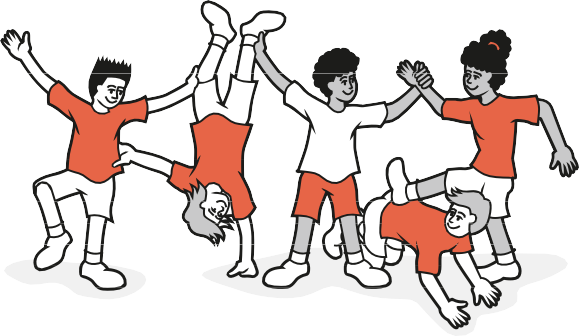
by Santosh | Jun 10, 2020 | Fitness Activity
Movement skills/concepts
Cooperative balances, counterbalance, space and body awareness, and relationships (with others).
Set-up
An area with an even surface. Groups of five or seven.
Activity
One child starts off the activity by selecting a balance with a wide base of support. In turn, each other child adds to the statue by slowly making another shape (wide/ narrow/curled/twisted) touching the first statue with one body part.
Once the group balance statue is complete, on a signal each child (except the first one) moves slowly away from the original single-child statue, using a locomotor or turning action.
On a signal, each child moves slowly back into the group statue, with well-defined shapes, and holds their balance.
On a signal, each child moves slowly away again, forming an individual statue by themselves with a base of support and a shape that is different from those used for the group statue.
Can you see …?
- tight muscles
- keeping still – like a statue
- smooth, slow movement
- counterbalance
You could ask …
What do you need to do to counterbalance?
Variations
Choose a theme and add a movement: Create the shape of an object and carry out the movements of that object (e.g. a washing machine).
COOL DOWN/ CLOSURE
Review Skill/Activity, stretching, and questions.









